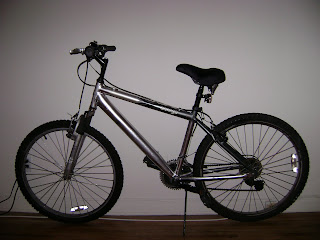
Ever since moving to NYC, I have been searching for a good transportation paradigm. Now the subway is a generic solution for getting around the urban landscape. But there are a plethora of annoyances with this method.
1. The fare is too pricey as is and the MTA is still increasing it.
2. Long wait times between trains during off-peak hours
3. Flooding in the subterranean tunnels after a bad thunderstorm.
4. Incredible levels of overcrowding during rush hour.
One really has to wonder if the subway is the best choice. For ~1000 USD ( MTA fare) a year, there has to be a more elegant solution to the problem of urban transportation. In comes the bicycle. This incredibly simple piece of 19th century technology suits the urban environment admirably. The bicycle is amazingly efficient, it takes roughly 30 calories to propel a person 1 mile on an average bicycle. If calories are converted into gasoline, the fuel efficiency of a bicycle(at 20 mi/hr) is around 900 miles per gallon! So a month ago, I decide to upgrade (or downgrade?) my transportation. I bought a used bike off
Craigslist. This purchase turned into a major lesson for me. I locked the bike outside my apartment for a single night and it was promptly stolen! Undeterred, I went back to Craigslist the next day and bought another used mountain bike for 50 dollars. This time I locked the bike up inside of my apartment building, thus preventing any local hooligans from further attempts at theft.

The standard mountain bicycle is in many ways more suitable for an urban environment than "road" or performance level bicycles. There are a myriad of reasons. Primarily, because most cities are not very bike friendly, the machine must be robust enough to handle all kinds of terrain(pavement, brick, asphalt, lawn, sand..etc). Furthermore,
NYC in particular doesn't really offer a very continuous bicycle path within and around the city. So when transitioning between bike paths, roads, and sidewalks, it gets rather bumpy. That is where a mountain bike's suspension system comes in.

I had to make a few additions to the used bike however. Frontal and rear LED lights had to be installed for night time journeys in traffic. A bell is also a must to alert pedestrians. When all was said and done, I had spent 80 dollars for the entire package, bike and accessories. A fully outfitted mountain bike is an enormously efficient machine to ride. Imagine a person running at full gallop, an experienced cyclist can comfortably ride at four times that speed, and keep it up for hours on end. On top of my souped up Quest Omega, the entire city opened up to me. Journeys that would've taken half a day on foot can now be accomplished within an hour. At a comfortable speed of 20-25 mph, I biked across the length of Manhattan island in just under 40 minutes. There were many points where my bike was going faster than cars. It is truly a wonder(perhaps an irony), that a muscle powered bike can exceed the performance of gas-guzzling cars in this city.
There are drawbacks however. When in bike lanes that share the same roads as cars, cycling can be a very dangerous activity. The issue stems from the fact that drivers of automobiles don't seem to give a damn about cyclists. Cars would park on long stretches of bike lanes, forcing the cyclists onto lanes reserved for other cars(thus increasing the chances of accidents). So while the bicycle pretty drastically reduces my dependency on the subway, it also increases my risk of a traffic accident. I think I'll need to practice some more before ditching my monthly subway pass! :P





